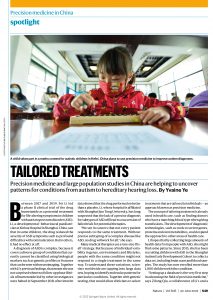
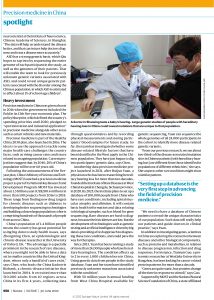

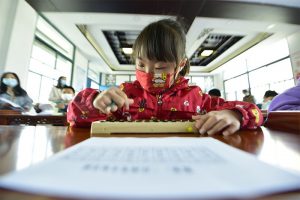
A child takes part in a maths contest for autistic children in Hefei. China plans to use precision medicine to improve autism diagnoses. Credit: Costfoto/Future Publishing via Getty
Between 2017 and 2019, Fei Li led a phase II clinical trial of the drug bumetanide as a potential treatment for life-altering symptoms in children with autism spectrum disorder (ASD). Li, a developmental–behavioural paediatrician at Xinhua Hospital in Shanghai, China, saw that in some children, the drug reduced the severity of ASD symptoms such as profound difficulties with communication. But in others, it had no effect at all1.
A diagnosis of ASD is complex, because it covers a diverse group of conditions that currently cannot be classified using biological markers such as genetic profiles or features that can be seen with neuroimaging. Together with Li’s previous findings, that meant she was not surprised when two follow-up phase III trials of bumetanide led by other investigators were halted in September 2021 after interim data showed that the drug performed no better than a placebo. Li, whose hospital is affiliated with Shanghai Jiao Tong University, has long suspected that the lack of a precise diagnosis for subtypes of ASD will lead to a succession of failed trials for potential therapies.
“We see in cancers that not every patient responds to the same treatment. Without precise subtyping of a complex disease like ASD, no drug will work for all,” she says.
Many medical therapies use a ‘one-size-fits-all’ strategy. But because of individual variability in genes, environments and lifestyles, people with the same condition might not respond to a single treatment in the same way. To understand these variations, scientists worldwide are tapping into large data sets, hoping to identify molecular patterns for particular conditions. Together with genetic testing, that would allow clinicians to select treatments that are tailored to individuals — an approach known as precision medicine.
The concept of tailoring treatment is already used in health care, such as finding donors who have a matching blood type when giving transfusions. The development of diagnostic technologies, such as tools to screen genes, proteins and even metabolites, could expand the approach to other areas of health care.
Li hopes that by collecting large amounts of health data from people with ASD, she might find some patterns. Since 2015, she has been recruiting children with ASD to the Shanghai Autism Early Development Cohort to collect a data set, including brain scans and blood samples. The study has now enrolled more than 1,000 children with the condition.
“Setting up a database is the very first step in advancing the field of precision medicine,” says Zilong Qiu, a collaborator of Li’s and a neuroscientist at the Institute of Neuroscience, Chinese Academy of Sciences, in Shanghai. “The data will help us understand the disease better, and that can in turn help doctors diagnose and treat a disease more accurately.”
ASD has a strong genetic basis, which Qiu hopes to tap into by sequencing the entire genome of each participant in the study, as well as the genomes of their parents. That will enable the team to look for previously unknown genetic variants associated with ASD, and could reveal unique genetic patterns associated with the disorder among the Chinese population, in which ASD is estimated to affect about 1% of school-age children2.
Heavy investment
Precision medicine in China was given a boost in 2016 when the government included the field in its 13th five-year economic plan. The policy blueprint, which defined the country’s spending priorities until 2020, pledged to “spur innovation and industrial application” in precision medicine alongside other areas such as smart vehicles and new materials.
Precision medicine is part of the Healthy China 2030 plan, also launched in 2016. The idea is to use the approach to tackle some major health-care challenges the country faces, such as rising cancer rates and issues related to an ageing population. Current projections suggest that, by 2040, 28% of China’s population will be over 60 years old.
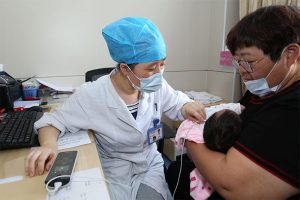
A doctor in Shaoxing tests a baby’s hearing. Large genetic studies of people with hereditary hearing loss in China could reveal mutations that are unique to that population. Credit: Shan Mingming/Costfoto/Sipa USA/Alamy
Following the announcement of the five-year plan, China’s Ministry of Science and Technology (MOST) launched a precision-medicine project as part of its National Key Research and Development Program. MOST has invested about 1.3 billion yuan (US$200.4 million) in more than 100 projects from 2016 to 2018. These range from finding new drug targets for chronic diseases such as diabetes to developing better sequencing technologies and building a dozen large population cohorts comprising hundreds of thousands of people from across China.
China’s population of 1.4 billion people means the country has great potential for using big data to study health issues, says Zhengming Chen, an epidemiologist and chronic-disease researcher at the University of Oxford, UK. “The advantage is especially prominent in the research of rare diseases, where you might not be able to have a data set in smaller countries like the United Kingdom, where only a handful of cases exist,” says Chen, who leads the China Kadoorie Biobank, a chronic-disease initiative that launched in 2004. It recruited more than 510,000 adults from 10 regions across China in its first 4 years, collecting data through questionnaires and by recording physical measurements and storing participants’ blood samples for future study. So far, the team has investigated whether some disease-related lifestyle factors that have been identified in the West apply to the Chinese population. They have just begun to dig into participants’ genetic data, says Chen.
Another big-data precision-medicine project launched in 2021, after Huijun Yuan, a physician who has been researching hereditary hearing loss for more than two decades, founded the Institute of Rare Diseases at West China Hospital in Chengdu, Sichuan province, in 2020. By 2025, the institute plans to set up a database of 100,000 people from China who have rare conditions, including spinal muscular atrophy and albinism. It will contain basic health information and data relating to biological samples, such as blood for gene sequencing. Rare diseases are hard to diagnose, because their incidences are low. But the development of technologies such as genetic testing and artificial intelligence driven by big data is providing a fresh approach to diagnosing these rare conditions, and could pave the way for therapies.
Since 2013, Yuan has been running a study of more than 24,000 people who have hereditary hearing loss. The condition affects up to 2 in every 1,000 children born in China. Using genetic data from people in the study database, Yuan and her team have identified previously unknown mutations associated with the condition3.
With 50 million yuan in annual funding from West China Hospital available for genetic sequencing, Yuan can sequence the whole genomes of all 24,000 participants in the cohort to identify more disease-related genetic variants.
“From our previous research, we see about two-thirds of the disease-associated mutation sites in Chinese patients [with hereditary hearing loss] are different from those identified in populations of different ethnicities,” she says. She suspects other rare conditions might show a similar pattern.
“We need to have a database of Chinese patients to reveal the unique characteristics of our population. Such data will really help our patients and guide doctors in clinical practice,” says Yuan.
In addition to investigating genes, scientists in China are exploring the connection between diseases and other biological components, such as proteins and metabolites, in relation to disease progression, infection and drug responses. For instance, Tiannan Guo, a proteomics researcher at Westlake University in Hangzhou, has been looking for cancer-related protein patterns for more than a decade.
“Genes are quite static, but proteins change all the time in response to stimuli,” says Guo.
Supported by MOST and the National Natural Science Foundation of China, a state-affiliated research funder, he is developing a software program that uses artificial neural networks to look for specific proteins in thyroid-nodule biopsies that can suggest signs of cancer4. About half of adults will develop thyroid nodules in their lifetime, but only a small proportion of nodules — 10% to 15% — turn out to be malignant and require surgical removal of the glands. But current diagnostic tools, including radiology scans, cell samples and gene testing, still leave 20–40% of the cases unclassified, depending on clinicians’ levels of experience.
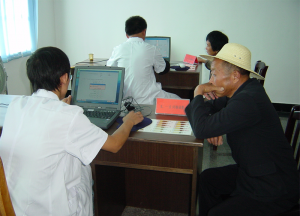
Participants in the China Kadoorie Biobank answer survey questions about lifestyle and medical history. The chronic-disease initiative has recruited more than 500,000 adults from 10 regions across China. Credit: Courtesy of Zhengming Chen
“When we can’t offer these patients a precise diagnosis and rule out the possibility of the nodule being malignant, many patients will insist on having surgery to remove it,” says Dong Xu, a radiologist at the Cancer Hospital of the University of Chinese Academy of Sciences in Hangzhou. But the surgery often involves removing the thyroid gland, which is responsible for producing hormones that support biological processes in the body. Patients then need to take thyroid-hormone replacements for the rest of their lives.
Xu and Guo are collaborating to develop a diagnostic system based on the neural network, with the aim of reducing this over-treatment. “The development in proteomics provides a new chance to solve the problem. If this tool is successful, it will greatly help us improve precise diagnosis and treatment of thyroid nodules,” Xu says. He adds that the tool can also expand health-care access at facilities in small towns and remote areas. Because of a lack of skilled doctors in these regions, patients often have to travel long distances to large hospitals in cities.
“It would be really helpful to have a tool to help local physicians make diagnoses,” Xu says.
Challenges ahead
As the funding cycle for many of the precision-medicine projects financed since 2016 ends, ongoing support will become crucial, says Chen — particularly given that cohorts usually take several years to build and are time-consuming and costly to maintain. His China Kadoorie Biobank, for example, has received $100 million in funding from multiple entities over 20 years, but “the really cutting-edge research is finally about to begin”, he says. Chen is hoping to secure substantial funding from both public and private sources to support the biobank’s future projects, which aim to tap into data on participants’ genes and proteins.
Financial support from MOST’s precision-medicine programme is usually for 4–5 years, and the amount — less than 20 million yuan per cohort study — is far from enough to sequence the genomes of the tens of thousands of participants enrolled in them. Using MOST’s funding, many of these large cohorts have just started in the past few years. Without strong and continuous support after the programme ends, Chen worries that the resources that have already been invested could be wasted. “The design of [MOST’s precision medicine] programme failed to account for the unique feature of cohort studies, which is that they take a long time to build before yielding any findings. You can’t have quick success,” he says.
Data sharing presents an additional challenge, in part because China’s health data are fragmented across various repositories, research teams and hospitals. In 2019, the Chinese government set up two open-access data centres to encourage data sharing — the National Genomics Data Center and its umbrella organization, the China National Center for Bioinformation — but not every research project deposits its data.
“Data’s value is only shown when it’s used. So it doesn’t help advance the field if you just hold on to it,” says Yuanting Zheng, a genetics researcher at Fudan University in Shanghai. China’s research evaluation system emphasizes factors such as first authorship of academic papers, which gives scientists less incentive to share the data freely, she adds.
“The problem is not that people don’t want to collaborate, but we don’t have a good system to encourage more of these types of project,” Zheng says. “I think if you want to get something done, especially in the cross-disciplinary fields, there will be people playing the supporting roles. And there should be a system that recognizes the importance of supporting roles.”
Yuan says precision medicine in China will grow rapidly in tandem with the country’s economy and research power, with projects such as the Institute for Rare Diseases leading the way. She says the institute is willing to provide a platform to help smaller projects that might not have the access or money to sequence their samples.
“We invested so much in building such a big platform, and we’re hoping to share it with other teams across the country. After we bring these fragmented resources together, the data will generate more value. It’s a win–win situation,” Yuan concludes.
Nature 606, S49-S51 (2022)
